List of coats of arms and flags of the Swiss cantons
This list contains the coats of arms and flags of the 26 cantons of Switzerland .
The names of the cantons are given in German, and in the case of cantons that are different or multilingual, in the respective official languages . The map in the left column shows the location of the canton, the column on the far right deals with the blazon of the coat of arms . If necessary, reference is made here to the main article of the coat of arms.
The flags of the cantons are heraldic banners with an aspect ratio of 1: 1.
list
The list is arranged in the official order according to the federal constitution .
| location | coat of arms | banner | Canton | Description of coat of arms |
|---|---|---|---|---|

|

|

|
Zurich | The oldest representation of this coat of arms comes from the year 1389. The first surviving copies of the banner date from 1437. The coat of arms is usually depicted with lions holding shields. The stand colors are blue and white. |

|

|
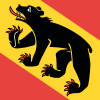
|
Bern ( French Berne ) |
The figure of the coat of arms, the bear, is an allusion to the name of the canton. The color black of the bear is supposed to represent defensiveness, the gold in the crossbar the noble blood, the red the blood of the fathers. The oldest illustration of this bear can be found on a coin from 1224. The colors of the state are red and black. |

|

|

|
Lucerne | In this case, the colors of the canton are older than those of the coat of arms (it was adopted in 1386). There the colors blue and white are arranged vertically. The stand colors are white and blue. |

|

|

|
Uri | The flag and coat of arms of the canton of Uri depicts the black head of an aurochs with an outstretched red tongue and a red nose ring on a yellow ( heraldic : golden) background. The bull's head is a talking coat of arms, because the first settlers are said to have called the country "ur" . The nose ring expresses the taming of the bull and the land. The stand colors are black and yellow. |

|

|

|
Schwyz | The banner of this canton has only had the color red since the end of the 13th century. The oldest surviving depiction of a flag with a white cross in the upper corner dates from 1470. It was possibly derived from the blood flag of the empire. The white cross can be traced back to a depiction of a saint placed in the upper corner of a flag. The white cross also appears on the two-lobed color flag. The stand color is red. |
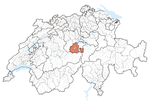
|

|

|
Obwalden | The colors of the coat of arms and the banner have been two-tone since the 13th century. The key of St. Peter first appeared on the seal in the 13th century. The stand colors are red and white. |
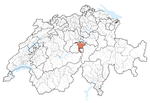
|

|

|
Nidwalden | The key is for St. Peter. Originally, the canton only had one key. The double key should probably represent the pursuit of equality with Obwalden. The stand colors are red and white. |

|

|

|
Glarus | The coat of arms of Glarus shows Saint Fridolin , the patron saint of the canton, who settled there in 500, on a red background. The status colors are red, black, white and red. |

|

|

|
train | The coat of arms and flag were initially identical to those of Austria , but were changed when Zug joined the Swiss Confederation in 1352. The coat of arms goes back to that of the Dukes of Austria, who wielded a silver bar in red. The stand colors are white-blue-white. |
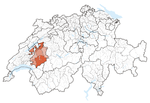
|

|

|
Freiburg ( French Friborg ) |
The flag was adopted in 1447. The canton's coat of arms is divided horizontally into two halves, black above and white below. The stand colors are black and white. |

|

|
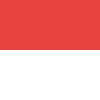
|
Solothurn | The canton's coat of arms is divided horizontally, red above and white below. Nothing precise is known about the reasons for the choice of color. Presumably it is related to the symbol invented by the Theban Legion in the Middle Ages . The patron saint Ursus is also shown with a red flag and a continuous white cross. The stand colors are red and white. |

|

|
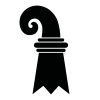
|
Basel city | The coat of arms of the city of Basel and the half-canton of Basel-Stadt is a black crook pointing to the left ( heraldic: right) on a white ( heraldic: silver) field, called the Baselstab . Three cross bars interrupt this rod, which widens towards the bottom and ends in three points. The current shape of the staff has been in use since the 13th century. The stand colors are white and black. |

|

|
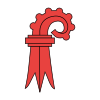
|
Basel-Country | On the coat of arms, a red crook pointing to the right ( heraldic: left) is depicted on a white field, called the Baselstab . Three crossbars interrupt this rod, which contains seven so-called crabs (points) at the top, widens towards the bottom and ends in three spikes. The coat of arms is based on the civil coat of arms of the city of Liestal and the coat of arms of the Principality of Basel . The stand colors are white and red. |
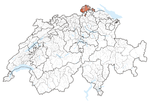
|

|
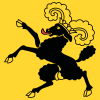
|
Schaffhausen | The ram in the coat of arms refers to the name of the city and the canton (Schaf-Hausen). The banner, which is older than the coat of arms, probably dates from the 13th century. The colors of the state have been green and black since the 15th century. |

|

|
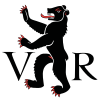
|
Appenzell Ausserrhoden | The coat of arms of the canton of Appenzell Ausserrhoden, like that of Appenzell Innerrhoden, shows a black, upright walking bear on a white (heraldic: silver) background. The letters "V" and "R" are on the left and right. The bear was taken from the coat of arms of the St. Gallen Abbey, the “VR” reads “UR” and stands for “Ussere Roden”, which means Ausserrhoden. The stand colors are white and black. |

|

|

|
Appenzell Innerrhoden |
The coat of arms of the canton of Appenzell Innerrhoden shows a black, upright walking bear on a white ( heraldic: silver) background. The bear was taken from the coat of arms of the St. Gallen Abbey. |

|

|

|
St. Gallen | The white bundle of rods ( fasces ) on a green background in the St. Gallen coat of arms comes from ancient Rome. When judges or high officials appeared in public, they were preceded by two or more lictors. As a symbol of the judiciary, they carried a bundle of rods with an ax. The stand colors are green and white. |

|

|

|
Graubünden ( Romansh Grischun , Italian Grigioni ) |
The coat of arms depicts the symbols of the three parts of the canton that came together in the 15th century: the Gray League (black and white), the Ten-Court League (blue-yellow cross) and the Church of God (Capricorn). The stand colors are gray, white and blue. |

|

|

|
Aargau |
The white wavy lines stand for the rivers Aare , Reuss and Limmat , the stars for the districts of the county of Baden , the open areas and Fricktal . |

|

|

|
Thurgau | The coat of arms of the canton of Thurgau shows two yellow, striding lions on a diagonally divided, white and green ground. The lions come from the coat of arms of the county of Kyburg . When the coat of arms was created, white was chosen as the color of innocence and green as the color of freedom. The stand colors are green and white. |

|

|

|
Ticino ( Italian Ticino ) |
The colors blue and red, which appear vertically on the coat of arms, were approved in 1930. The colors were determined on May 23, 1803, but there is no evidence of the choice of color. The status colors are red and blue. |

|

|

|
Vaud ( French Vaud ) |
The French motto is “Liberté et patrie” ( German “Freedom and Fatherland” ). The color green symbolizes freedom and goes back to the Lemanic Republic proclaimed on January 23, 1798 . The stand colors are white and green. |

|

|
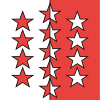
|
Wallis ( French Valais ) |
The forerunner of the banner, which is older than the coat of arms, was the silver-red split coat of arms of the diocese of Sion, first mentioned in 1220 . The first official representation of the coat of arms dates from 1548. Stars has only been shown on the coat of arms since 1507. The stars represent the canton's 13 tens . The stand colors are red and white. |

|

|

|
Neuchâtel ( French Neuchâtel ) |
The green of the flag stands for freedom, while white and red are the traditional colors of Switzerland. The status colors are green, white and red. |

|

|
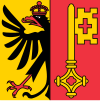
|
Geneva ( French Genève ) |
The black eagle is the emblem of the Holy Roman Empire, the key the symbol of Peter. The oldest representation of the coat of arms can be found in two books that were published in 1451. The status colors are yellow and red. |

|

|

|
Jura ( French Jura ) |
The bishop's staff ( Basel staff ) refers to the former affiliation to the Principality of Basel. The stripes represent the seven districts that wanted to form a new canton, but ultimately there were only three. The stand colors are white and red. |
See also
- Flag and coat of arms of Switzerland
- List of local coats of arms with the scallop shell in Switzerland
literature
- Louis Mühlemann: coat of arms and flags of Switzerland. 700 years of Confoederatio Helvetica, 3rd edition, Lengnau 1991.
- Galliker, Joseph Melchior: Swiss coats of arms and flags. a series of publications by the Swiss Coat of Arms and Flags Foundation, 8 booklets, Zug 1987–2005.
- Swiss Army (Ed.): Dealing with flags, standards and fanions (flag regulations) (PDF; 11.4 MB). Regulations 51.340 d. Valid from January 1st, 2008.
Individual evidence
- ↑ Flag Regulations of the Swiss Armed Forces ( Memento of the original dated November 6, 2011 in the Internet Archive ) Info: The archive link was inserted automatically and has not yet been checked. Please check the original and archive link according to the instructions and then remove this notice. (PDF; 11.4 MB), p. 56
- ↑ Flag Regulations of the Army ( Memento of the original dated November 6, 2011 in the Internet Archive ) Info: The archive link was inserted automatically and has not yet been checked. Please check the original and archive link according to the instructions and then remove this notice. (PDF; 11.4 MB), p. 70
Web links
- Peter F. Kopp: coat of arms. In: Historical Lexicon of Switzerland .
- Coats of arms of the Swiss cantons in the official coat of arms dictionary (English)
- swissflags.net ( Memento from September 18, 2006 in the Internet Archive )